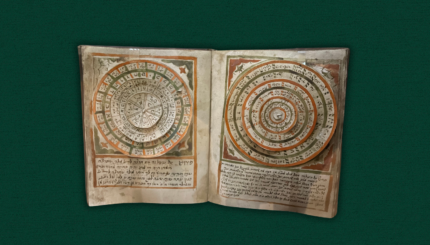According to Jewish tradition, the Torah has seventy “faces,” but is still one, unified Torah. On Shavuot, we celebrate the giving of Torah at Mount Sinai with customs that celebrate the gift of Torah, and show the same diverse presentation of a few unifying core ideas. Each Jewish culture is unique, and at the same time, integrated with the worldwide Jewish community.
There are many special foods for Shavuot, in different Jewish cultures. Dairy is popular because, when the Israelites in the desert received the Torah, including the kosher laws, there was no kosher meat yet available. Torah is compared to honey, so many traditional Shavuot foods are sweet, as well. Persian Jews make “Polao mastin” a dish made of rice and milk, and “koltcha shiri,” a dairy cake, while in Greece there is a special dairy porridge made with cinnamon called “sutlag.” In Poland, cheesecake is the traditional Shavuot dessert. Libyan Jews make necklaces strung with cookies or pretzels in symbolic shapes for their children. Iraqi Jews make “sambusak,” a savory pastry filled with cheese. The exact details of the menu are fluid—any interpretation of a dairy meal and dessert would be appropriate. This is an excellent opportunity to try out a new recipe, symbolic of our renewed relationship with Torah, or to take the time for an old family favorite, to celebrate your roots.
It is common for communities to prepare their synagogues for Shavuot with natural decorations. Greek Jews historically decorated their synagogues with green branches and a variety of flowers. Even today Bukharan Jews use red roses. In Poland, synagogues were decorated with flowers, branches, and paper cuttings called “reizelach,” or roses, in Yiddish. German Jews would place two flowering branches on either side of the Ark, as a symbol that Torah is our Tree of Life. Consider decorating your synagogue or home with local, in season, flowers and greenery.
Traditional communities hold a “Tikkun Leil Shavuot,” a nighttime Torah study session which can last anywhere from a couple of hours to all night long. In some communities this is held in the synagogue, while in others, it is located private homes. People may recite specific passages from different traditional texts, while others prepare different topics, which change from year to year. Study is a potent way of renewing our understanding of Torah.
Shavuot is full of opportunities for communal gatherings and fun. Libyan and Moroccan Jews spray water onto passersby, because the Torah is compared to water, and our reconnection to Torah is a source of blessing. Ethiopian Jews gather together, bringing bread and other grains for the Kes, their religious leader, to bless, after which the entire community eats together. On some Israeli Kibbutzim, people have revived the agrarian side of Shavuot and have a parade with baskets of the first produce of the season. Whether you want to make a meal with seasonal produce, or have a picnic and water balloon fight, you will be in good company among the global Jewish community.
Around the world, Jews celebrate Shavuot in a variety of ways—but at their root, they come back to the same sources and the same ideas. It celebrates the diverse ways in which we relate to Torah, all of which are true, just as we have diverse ways of celebrating, all of which are the real Jewish way to do things. One thing is for certain—whichever way you choose to celebrate Shavuot this year, you will meet one of Torah’s seventy faces.
kosher
Pronounced: KOH-sher, Origin: Hebrew, adhering to kashrut, the traditional Jewish dietary laws.
Shavuot
Pronounced: shah-voo-OTE (oo as in boot), also shah-VOO-us, Origin: Hebrew, the holiday celebrating the giving of the Torah at Mount Sinai, falls in the Hebrew month Sivan, which usually coincides with May or June.
Torah
Pronunced: TORE-uh, Origin: Hebrew, the Five Books of Moses.



